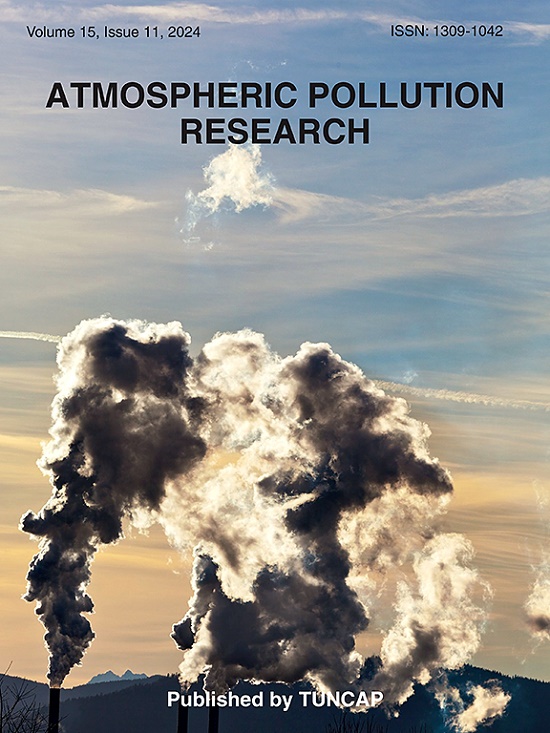塑料跑道上空单芳烃污染特征及健康风险评价
IF 3.5
3区 环境科学与生态学
Q2 ENVIRONMENTAL SCIENCES
引用次数: 0
摘要
聚氨酯(PU)塑料跑道排放的单芳香烃(MACHs)会对在这些跑道上或附近进行运动的人造成健康风险。然而,人们对这些跑道上方空气中mach的具体污染特征和相关的健康风险仍然知之甚少。本研究调查了2023年8 - 9月湖北省新建的22条塑料跑道(30-90天)。采用罐样取样、预富集和气相色谱-质谱联用(GC-MS)技术鉴定和定量了mahs的浓度。根据美国环境保护署(EPA)风险评估框架,评估了与接触甲基丙烯酸甲酯相关的健康风险。在塑料跑道上方的空气中持续检测到16种马赫化合物,检出率为100%。检测到的化合物质量浓度由高到低依次为:甲苯(8.39±7.76 μg/m3) >;间二甲苯/对二甲苯(4.76±4.29 μg/m3);苯(3.23±1.86 μg/m3);乙苯(3.20±2.78 μg/m3);1,2,4-三甲苯(2.52±3.44 μg/m3) >;邻二甲苯(1.61±1.41 μg/m3)。主要化合物的非致癌风险排名如下:苯;二甲苯异构体>;1,2,4-三甲苯>;1,2,3-三甲苯>;1,3,5-三甲苯>;乙苯祝辞甲苯。所有检测到的化合物的危害商(HQ)值均小于1。苯和乙苯的致癌风险估计值在10−6至10−4之间。塑料跑道上方的苯、甲苯、乙苯和二甲苯(BTEX)浓度高于城市环境空气中通常观察到的浓度。然而,非致癌性和致癌性风险都与城市环境空气相似,因为人们在塑料跑道上的接触时间和接触频率较低。虽然BTEX的浓度与化学工业区附近的浓度相似,但明显低于化学工业园区内的浓度。相应的,相关健康风险显著低于工业园区环境。研究结果表明,mach的非致癌性风险水平在可接受的阈值范围内,苯、二甲苯异构体和1,2,4-三甲苯被确定为非致癌性影响的主要因素。苯和乙苯造成的致癌风险值得注意,表明长期接触可能对健康造成危害,特别是对敏感人群。塑料跑道上方与btex相关的健康风险与城市环境相当,但明显低于地下车库或化学工业园区的风险。这项研究支持在公共场所广泛使用塑料跑道,但强调需要定期监测BTEX,提高公众对健康风险的认识,以及适当的运动持续时间和强度,以减轻潜在风险。本文章由计算机程序翻译,如有差异,请以英文原文为准。

Characteristics and health risk assessment of monoaromatic hydrocarbons pollution in air above plastic runways
Monoaromatic hydrocarbons (MACHs) emitted from polyurethane (PU) plastic runways can pose health risks to individuals engaging in sports on or near these runways. However, the specific pollution characteristics and associated health risks of MACHs in the air above these runways remain poorly understood. This study investigated 22 newly constructed plastic runways in Hubei Province (aged 30–90 days) between August and September 2023. MACHs concentrations were identified and quantified using canister sampling coupled with preconcentration and gas chromatography-mass spectrometry (GC-MS). The health risks associated with MACHs exposure were assessed following the United States Environmental Protection Agency (US EPA) risk assessment framework. Sixteen MACHs compounds were consistently detected in the air above the plastic runways, with a detection rate of 100 %. The mass concentrations of the detected compounds followed this descending order: toluene (8.39 ± 7.76 μg/m3) > m-xylene/p-xylene (4.76 ± 4.29 μg/m3) > benzene (3.23 ± 1.86 μg/m3) > ethylbenzene (3.20 ± 2.78 μg/m3) > 1,2,4-trimethylbenzene (2.52 ± 3.44 μg/m3) > o-xylene (1.61 ± 1.41 μg/m3). Non-carcinogenic risks for the major MACHs compounds were ranked as follows: benzene > xylene isomers >1,2,4-trimethylbenzene >1,2,3-trimethylbenzene >1,3,5-trimethylbenzene > ethylbenzene > toluene. The hazard quotient (HQ) values for all detected compounds were below 1. Carcinogenic risk estimates for benzene and ethylbenzene fell within the range of 10−6 to 10−4. Benzene, toluene, ethylbenzene and xylenes (BTEX) concentrations above the plastic runways were higher than those typically observed in urban ambient air. However, both non-carcinogenic and carcinogenic risks were found to be similar to those in urban ambient air due to the lower exposure times and exposure frequency for people on plastic runways. While BTEX levels resembled those found near chemical industrial zones, they were markedly lower than concentrations within chemical industrial parks. Correspondingly, the associated health risks were significantly lower than those in industrial park environments. The findings suggest that the non-carcinogenic risk levels of MACHs were within acceptable thresholds, with benzene, xylene isomers, and 1,2,4-trimethylbenzene identified as primary contributors to non-carcinogenic effects. Carcinogenic risks posed by benzene and ethylbenzene were notable, suggesting potential health hazards with prolonged exposure, particularly for sensitive populations. BTEX-related health risks above plastic runways were comparable to those in urban environments but markedly lower than risks in underground garages or chemical industrial parks. This study supports the widespread use of plastic runways in public spaces but emphasizes the need for regular BTEX monitoring, public awareness of health risks, and appropriate exercise durations and intensities to mitigate potential risks.
求助全文
通过发布文献求助,成功后即可免费获取论文全文。
去求助
来源期刊

Atmospheric Pollution Research
ENVIRONMENTAL SCIENCES-
CiteScore
8.30
自引率
6.70%
发文量
256
审稿时长
36 days
期刊介绍:
Atmospheric Pollution Research (APR) is an international journal designed for the publication of articles on air pollution. Papers should present novel experimental results, theory and modeling of air pollution on local, regional, or global scales. Areas covered are research on inorganic, organic, and persistent organic air pollutants, air quality monitoring, air quality management, atmospheric dispersion and transport, air-surface (soil, water, and vegetation) exchange of pollutants, dry and wet deposition, indoor air quality, exposure assessment, health effects, satellite measurements, natural emissions, atmospheric chemistry, greenhouse gases, and effects on climate change.
 求助内容:
求助内容: 应助结果提醒方式:
应助结果提醒方式:


